ASM Metals HandBook Vol. 8 - Mechanical Testing and Evaluation
Подождите немного. Документ загружается.


where the load is directly measured, these methods warrant measurement of incident velocity, V
i
, of the
indenter for determining the dynamic hardness, H
d
, as per the following equation (Ref 15, 16):
(Eq 1)
where M is the mass of the indenter and U is the unrelaxed volume of the indentation imprint on the specimen.
This relationship assumes that the ratio of decrease in indentation volume due to the elastic recovery to
unrelaxed volume is the same as the ratio of rebound velocity to incident velocity of a spherical ball. Another
assumption is that the resistance to indentation is constant throughout the deformation, but this assumption has
been questioned by several authors (Ref 16, 17). Moreover, it is difficult to control the loading duration in this
approach because it depends on the frictional properties and coefficient of restitution (which itself varies with
indenter velocity) between the specimen and the indenter. The loading duration and the strain rate during the
deformation are estimated (not directly measured) based on the energy absorbed to create the crater and the
rebound height of the indenter. Therefore, these rebound methods do not parallel the simplicity of the static
indentation test method where the indentation load and the contact time are directly measured to determine the
static indentation hardness.
Commercial devices, such as Equotip hardness testers, based on rebound techniques also have emerged in the
market (Ref 18). In this method, the hardness of a material is not determined, but a numerical measure called an
“Equotip hardness number,” which is proportional to the ratio of rebound velocity to impact velocity, is used to
represent the hardness. However, this number has not been correlated to the established hardness measures such
as Rockwell, Brinell, or Vickers hardness numbers.
Pendulum Method. Nobre and others (Ref 16) used a pendulum machine to investigate the surface resistance of
a ductile steel to impact by hard ceramic balls. The pendulum is equipped with a piezoelectric transducer that
enables the history of impact as well as the velocity of pendulum before and after the impact to be obtained.
Obviously, the impact force or indentation load can be controlled by the amplitude of displacement from the
mean position where the specimen is situated. Similar to the rebound method, the duration of contact with the
specimen cannot be controlled in this technique because it depends on the resistance offered by the specimen
material, which is a function of the geometry and materials properties. Therefore, assumptions similar to those
in the rebound technique also should be made in this method to determine the dynamic hardness, and all these
factors render this technique different from the method for static hardness determination.
The basic disadvantage of these methods is that neither the indentation load nor the duration of the indentation
are precisely controlled a priori. This makes the determination of dynamic hardness nontrivial compared with
the static hardness testing where the hardness is determined by a simple relationship based on the measured
load and the size of the indentation imprint. Therefore, a technique that parallels the method for static
indentation hardness determination, where the indentation load and the size of indentation are directly
measured, can be of significant practical value for comparison of the static and dynamic hardness
measurements and for determination of strain-rate-sensitive properties of materials.
References cited in this section
1. D. Tabor, A Simple Theory of Static and Dynamic Hardness, Proc. R. Soc. (London), Vol 192A, 1948,
p 247–274
13. D.B. Marshall, A.G. Evans, and Z. Nisenholz, Measurement of Dynamic Hardness by Controlled Sharp-
Projectile Impact, J. Am. Ceram. Soc., Vol 66 (No. 8), 1983, p 580–585
14. G. Sundararajan and P.G. Shewmon, The Use of Dynamic Impact Experiments in the Determination of
the Strain Rate Sensitivity of Metals and Alloys, Acta Metall., Vol 31, 1983, p 101–109
15. Y. Tirupataiah and G. Sundararajan, A Dynamic Indentation Technique for the Characterization of the
High Strain Rate Plastic Flow Behavior of Ductile Metals and Alloys, J. Mech. Phys. Solids, Vol 39,
1991, p 243–271

16. J.P. Nobre, A.M. Dias, and R. Gras, Resistance of Ductile Steel Surface to Spherical Normal Impact
Indentation: Use of Pendulum Machine, Wear, Vol 211, 1997, p 226–236
17. C.H. Mok and J. Duffy, The Dynamic Stress-Strain Relation of Metals as Determined from Impact
Tests with Hard Ball, Int. J. Mech. Sci., Vol 7, 1965, p 355–371
18. “Standard Test Method for Equotip Hardness Testing of Steel Products,” A 956–96, Annual Book of
ASTM Standards, ASTM, Vol 01.05, 1997
Dynamic Indentation Testing
G. Subhash, Michigan Technological University
Dynamic Indentation Hardness Testing
One of the basic requirements for conducting indentation testing is the ability to deliver a single indentation
load. Methods based on the split Hopkinson pressure bar (SHPB) were adopted by Mok and Duffy (Ref 17),
where repeated loading due to wave reflections that occur in an incident bar were avoided by using a rigid
stopper. Again, the load was not directly measured but calculated based on several assumptions. Although this
method offers an ad hoc, or temporary, solution to create a single dynamic indentation, none of the methods
offer the elegance and simplicity of the recovery bar momentum-trapping device developed for SHPB (see Ref
19 and the article “Recovery Hopkinson Bar Testing” in this Volume). With proper instrumentation, this
technique can be effectively used (Ref 20, 21, 22) to determine the dynamic indentation hardness of metals and
ceramics. The method does not use any of the theoretical formulations developed in previously described
methods to determine either the load or the duration of impact. The hardness is determined by directly
measuring the load and the size of indentation, exactly similar to the procedure used for static-hardness
determination. The velocity of the indenter during the penetration of the indenter into the specimen is also
measured directly to obtain a more accurate picture of the resistance of the specimen and the velocity of the
indenter during the impact. This information is later used to calculate the strain rate of deformation and to
verify the hardness measurements with the yield stress values obtained from uniaxial stress-strain response at
similar strain rates.
Test Setup. The test setup comprises four major parts: a gas gun to propel a short striker rod; a long, slender rod
with a strain gage mounted at the center; a high-frequency load cell; and a cantilever beam with a strain gage.
The long, slender rod (length-to-diameter ratio >20) is designed with an integral “flange-sleeve-rigid mass”
assembly, called the momentum trap (MT), at one end and an indenter mounted in a housing at the other end.
The long, slender rod is the same as the incident bar in the modified SHPB (Ref 19) described in the article
“Recovery Hopkinson Bar Techniques” in this Volume. The assembly is made of heat treated high-strength
maraging steel. The inner diameter of the sleeve and the rigid mass is designed to slide smoothly over the
incident bar. The outer diameter of the sleeve is designed to match the impedance of the incident rod, where
impedance is defined as the product of the area of cross section, density, and wave velocity. Since both the
sleeve and the incident rod are made of the same material, the outer diameter of the sleeve is calculated based
on the cross-sectional area of the rod. The outer diameter and the length of the rigid mass are arbitrary but
typically range between 8 and 10 times the diameter of the incident bar. The flange diameter is the same as the
outer diameter of the sleeve. All the contact surfaces between the flange, sleeve, and rigid mass are carefully
polished to a high degree of flatness for effective transfer of wave energy during the operation. More details of
the momentum-trap design can be found in Ref 19 and the article “Recovery Hopkinson Bar Techniques” in
this Volume.
A high-frequency (200 kHz) load cell is mounted on a separate rigid base at the indenter end of the incident bar.
The load-cell signal is passed through a charge amplifier into a digital oscilloscope. A specimen material of
suitable dimensions, preferably the same diameter and length of the load cell (6 mm), is sandwiched between

the indenter and the load cell. A thin metallic strip mounted with a 350 Ω strain gage in the center is held fixed
at one end with its free end resting against the indenter base in the housing. This metallic strip acts as a
cantilever beam with its free end moving in unison with the indenter during the hardness testing. The
configuration of the dynamic indentation testing device is shown in Fig. 1. A short striker bar is launched from
a gas gun to make a planar impact on the sleeve end of the incident bar. The diameter of the striker bar is the
same as that of the incident bar, and the length is typically kept the same as the sleeve length. The impacting
surfaces are made flat and perpendicular to the bar axis so that a planar impact is ensured during the operation.
Fig. 1 Experimental setup for dynamic indentation hardness measurements
An alternate design (Ref 21) places the load cell between the indenter and the incident bar. This configuration is
suitable when indentation hardness measurements are to be performed on large specimens. Although the
hardness measurements were statistically the same in both configurations, the signal generated by the load cell
in the later configuration was extremely noisy due to the stress-wave interactions at the interface between the
load cell and the incident bar.
Operation. Before describing the operation of the dynamic hardness tester or the incident bar with a momentum
trap, it is imperative to understand the elastic stress-wave-propagation phenomena in a slender rod without the
momentum trap. Assume an incident bar with a strain gage mounted at the center of the rod. A short striker bar
is propelled from a gas gun to cause an impact at one end of the incident bar. Figure 2(a) illustrates the strain-
gage signal obtained from an incident bar without the momentum trap. Upon impact of the striker bar onto an
incident bar, a single compression pulse (C
impact
) is generated in the incident bar whose amplitude is
proportional to the velocity of the impacting striker bar, and the duration is equal to the round-trip travel time of
the longitudinal wave in the striker bar. If an indenter is attached to the other end of the incident bar (illustrated
on the top of the strain-gage signals), the compression wave will reach the indenter end and cause the indenter
to penetrate the specimen. Since the indenter tip has a negligible area, it acts as a free end, and the compression
pulse will reflect as a tensile pulse (T
impact
) traveling back toward the impact end. Upon reaching this end, this
tensile pulse reflects back again as a compression pulse and travels toward the indenter to cause another
indentation. This process will repeat several times, causing multiple indentations, thus making the incident bar
without the momentum trap unsuitable for indentation investigations and hardness determination where a single
indentation imprint is desired.
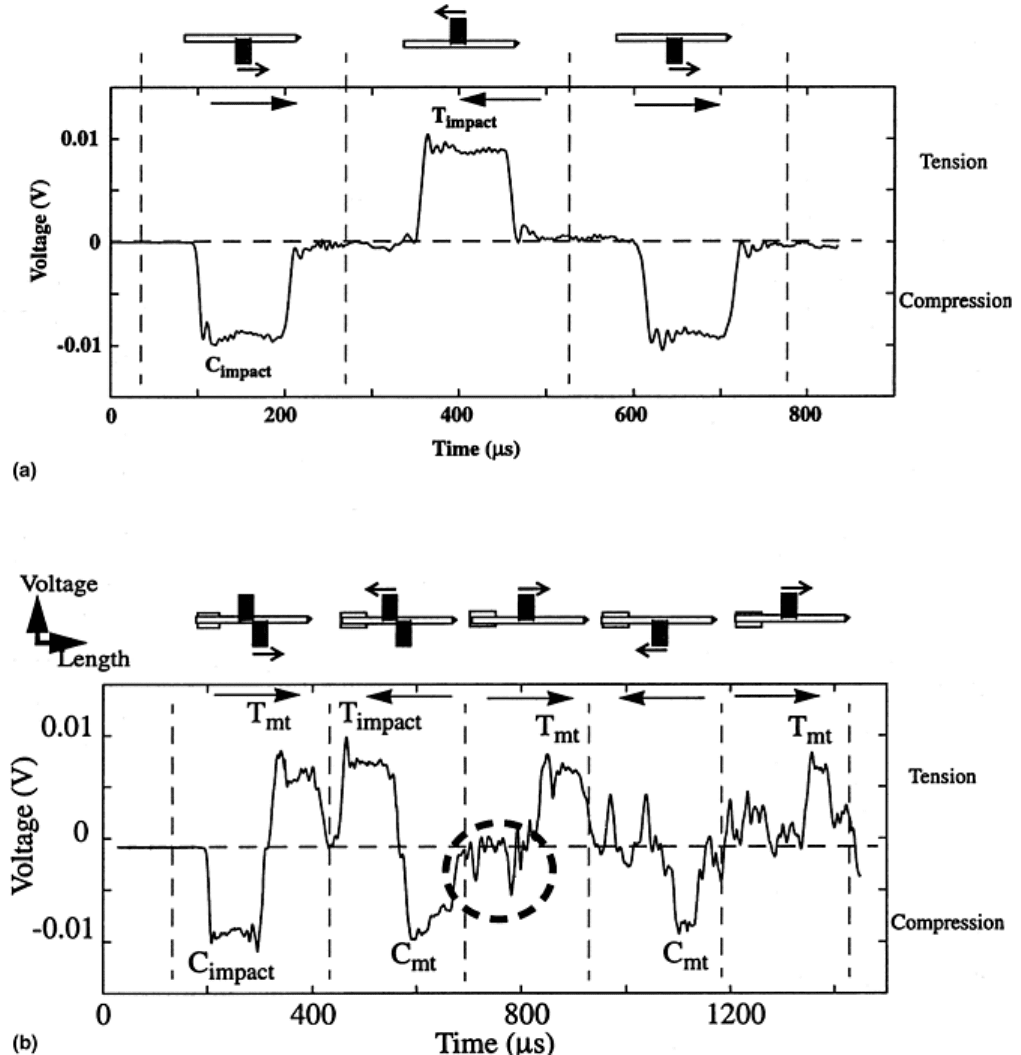
Fig. 2 Strain-gage signals revealing the stress pulses in the incident bar (a) in the absence of the
momentum trap and (b) with the momentum trap. The illustrations on top of the strain signals indicate
the physical position of these pulses in the bar.
To avoid multiple indentations, a momentum-trap assembly is designed at the impact end of the incident bar, as
shown in Fig. 1. Upon impact of the striker onto the flange end of the incident bar, compressive stress pulses
are generated in both the incident bar and the sleeve. The pulse in the sleeve travels toward the rigid mass and
reflects back as a compressive pulse at the rigid mass. Since the particle velocity in a compression wave is in
the direction of wave travel, upon reaching the flange end, the materials particles within the wave push against
the flange, thus loading a tensile pulse into the incident bar. Therefore, the strain gage mounted at the center of
the incident bar will record a compressive pulse (C
impact
) followed by a tensile pulse (T
mt
)—as indicated in the
strain-gage signal shown in Fig. 2(b)—both traveling toward the indenter. The compression pulse causes the
desired indentation upon reaching the indenter and reflects back as a tension pulse (T
impact
) similar to the
situation in the incident bar without the momentum trap described previously. The original tensile pulse (T
mt
),
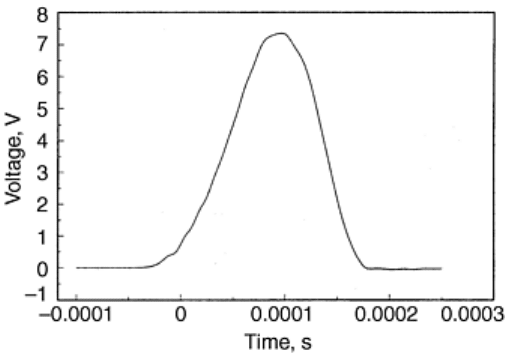
upon reaching the indenter, retracts the indenter away from the specimen and reflects back as a compression
pulse (C
mt
) into the incident bar.
Both these reflected pulses (T
impact
and C
mt
) now travel toward the flange end (shown in the illustrations with
arrows on top of the strain-gage signals). Upon reaching the sleeve end, the T
impact
is captured by the
momentum-trap assembly and separates the contact between the flange and the sleeve. Therefore, the strain
gage on the incident bar will not sense this pulse in its subsequent readings. A circle indicating the position of
the trapped pulse is illustrated in Fig. 2(b). The C
mt
will reflect back as a tensile pulse, T
mt
(due to the free-
boundary condition at the flange end), and travel toward the indenter. This pulse will travel back and forth in
the incident bar as a tensile pulse while traveling toward the indenter and as a compressive pulse while traveling
toward the flange, until it is eventually dissipated. In both situations, the incident bar moves farther away from
the specimen, thus avoiding repeated indentations. Thus, by designing the momentum trap suitably, it can be
ensured that only a single compression pulse reaches the indenter end, thus allowing dynamic indentation tests
to be performed at high strain rates.
In this method, the incident pulse impact duration and amplitude are independent of the indenter-specimen
interactions, and hence, the impact duration is maintained irrespective of the specimen properties. The reflected
pulse (i.e., T
impact
) contains information on the specimen and, therefore, can provide some estimate of the
indentation load. However, any effort to obtain the load estimate from the reflected signal will warrant a prior
knowledge of the specimen properties and some assumptions on the energy absorbed in the specimen, thus
making this method different from that of static indentation testing, where the load is directly measured. To
accomplish this objective, a high-frequency load cell is mounted rigidly on a separate base. The specimen is
sandwiched between the indenter and the load cell and is held by a small compression force.
Similar to static testing, the indenter is placed in contact with the specimen before the striker is impacted onto
the incident bar. By choosing a long incident bar, normal impact is ensured in the experiment without causing
any rotation of the indenter. After the dynamic indentation, the load experienced by the specimen during the
indentation is captured by the load cell and recorded on a digital oscilloscope. Figure 3 is a typical load-cell
signature during indentation of a metallic specimen. The peak indentation load is measured from this pulse. The
size of the indentation imprint on the specimen is measured after the experiment to calculate the dynamic
hardness according to ASTM E 92-82 (Ref 23):
Vickers hardness = 1.8544 P/d
2
(Eq 2)
where d is the average indentation diagonal, and P is the peak load measured by the load cell. For comparison
purposes, static hardness measurements were made using a hardness tester at suitable loads of 15 s duration. In
both static and dynamic cases, a diamond Vickers indenter with a 136° apex angle is used.
Fig. 3 Typical load-cell signal during indentation on a metal
Measurement of Time of Contact. The displacement of the indenter is fully controlled by the duration and
amplitude of the initial compression pulse (C
impact
), and hence, the time of contact between the indenter and the
specimen is the same as the duration of the initial compression pulse. Note that in a rebound method the time of
contact is controlled by specimen and indenter properties (e.g., coefficient of restitution, frictional
characteristics, and so on). In the current method, the velocity of the indenter is measured using a steel strip as a
cantilever beam with its free end resting against the indenter base as shown in Fig. 1. A strain gage mounted on
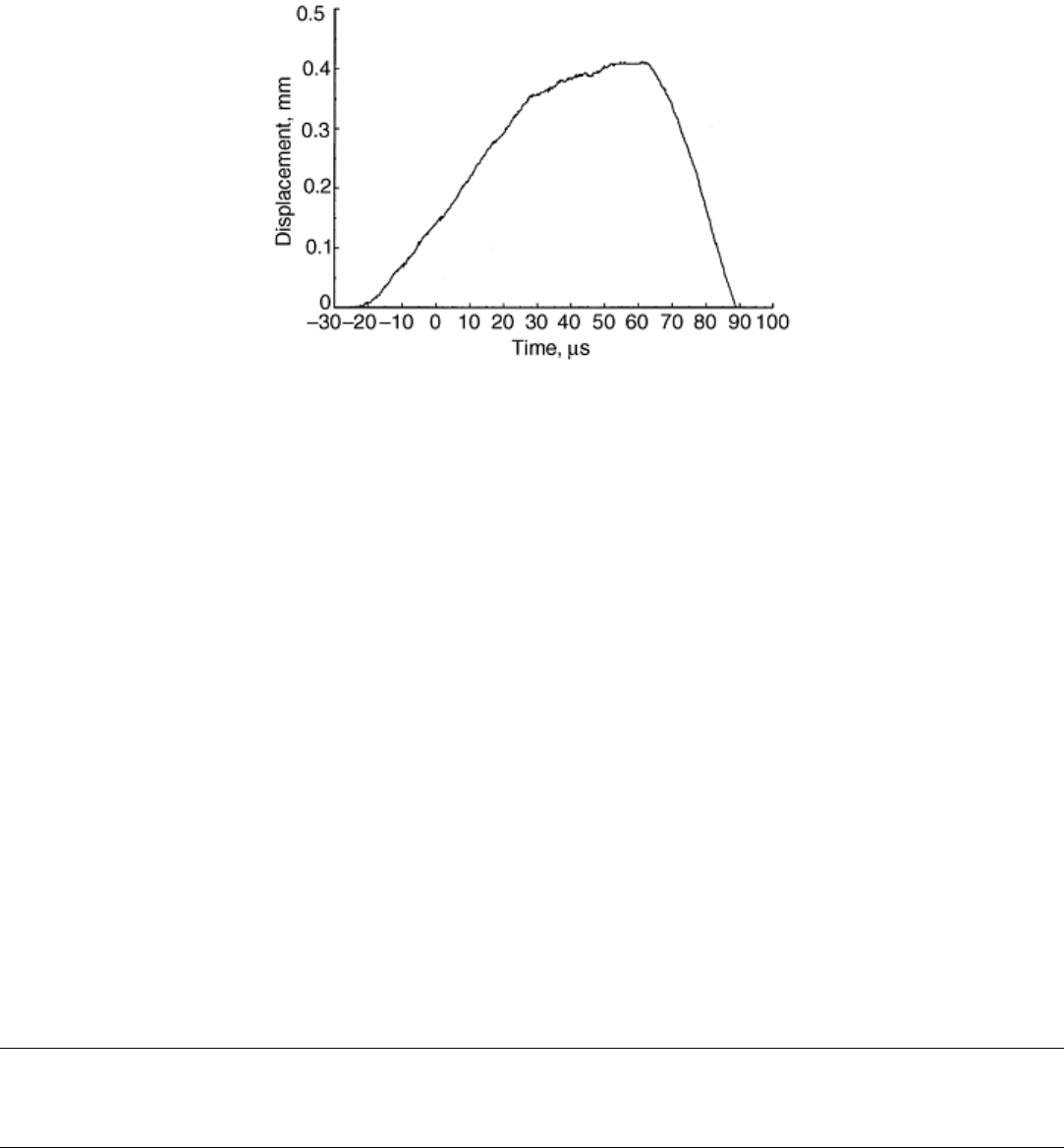
the steel strip monitors the displacements of the free end as the indenter penetrates into the specimen. The
voltage generated by the strain gage is converted to the deflection at the free end using simple beam theory.
Figure 4 illustrates a typical profile of the movement of the tip of the cantilever beam during the indentation on
a steel specimen.
Fig. 4 Profile of strain-gage signal mounted on the cantilever beam, indicating the depth of indentation
as a function of time
References cited in this section
17. C.H. Mok and J. Duffy, The Dynamic Stress-Strain Relation of Metals as Determined from Impact
Tests with Hard Ball, Int. J. Mech. Sci., Vol 7, 1965, p 355–371
19. S. Nemat-Nasser, J.B. Isaacs, and J.E. Starrett, Hopkinson Techniques for Dynamic Recovery
Experiments, Proc. R. Soc. (London) A, Vol 435, 1991, p 371–391
20. B.J. Koeppell and G. Subhash, Characteristics of Residual Plastic Zone under Static and Dynamic
Indentations, Wear, Vol 224, 1999, p 56–67
21. G. Subhash, B.J. Koeppel, and A. Chandra, Dynamic Indentation Hardness and Rate Sensitivity in
Metals, J. Eng. Mater. Technol. (Trans. ASME), Vol 121, 1999, p 257–263
22. R.J. Anton and G. Subhash, Dynamic Vickers Indentation of Brittle Materials, Wear, in press
23. “Standard Test Method for Vickers Hardness of Metallic Materials,” E 92–82, Annual Book of ASTM
Standards, Vol 03.01, ASTM, 1996
Dynamic Indentation Testing
G. Subhash, Michigan Technological University
Test Results
A range of commercially available metals and ceramics have been tested by this method. Dynamic indentation
hardness measurements on metals, when compared with the yield stress obtained at similar strain rates, verify
the validity of the Tabor's relationship H = 3 × Y, where H is the hardness and Y is the yield strength at 8%
strain. To further validate the dynamic indentation results, the plastic zone size beneath the indentation in
metals also has been measured as a function of the rate of indentation. Indentation hardness measurements on
brittle materials also have been done. The extent of cracks generated from the corners of the indentation can be
correlated to the strain-rate effects in these ceramics.
Dynamic indentation hardness of metals has been tested on several commercial aluminum, copper, steel, and
titanium alloys with specimens of 4 to 6 mm diameter and 8 to 10 mm length. The diameter of the specimens
was limited by the size of the load cell used in the experimental setup. The loading surfaces of each specimen
were metallographically prepared and polished down to 6 μm surface finish. Figure 5 presents the load versus
the square of the average indentation diagonal for both static and dynamic indentations on the test materials. A
regression line is plotted through each set of data. The slope of this line multiplied by 1.8544 (Eq 2) gives the
hardness. Note that the slope of the dynamic Vickers hardness (DHV) data is consistently greater than the static
Vickers hardness (HV) data. The straight-line nature of the data indicates that the hardness is relatively constant
in the range of loads used in these experiments. The hardness measurements obtained from these plots, as well
as the percent increase in dynamic hardness over the static hardness, that is, ([DHV-HV]/HV) × 100, are
summarized in Fig. 6. For aluminum and copper alloys, which have a face-centered cubic (fcc) structure, the
percentage increase in hardness at higher rates varies between 2 and 10%. For steels (most of the commercial
steels have complex crystal structure), this increase is between 10 and 20%, and for titanium and its alloys
(hexagonal closed-pack structures), it is well above 20%.
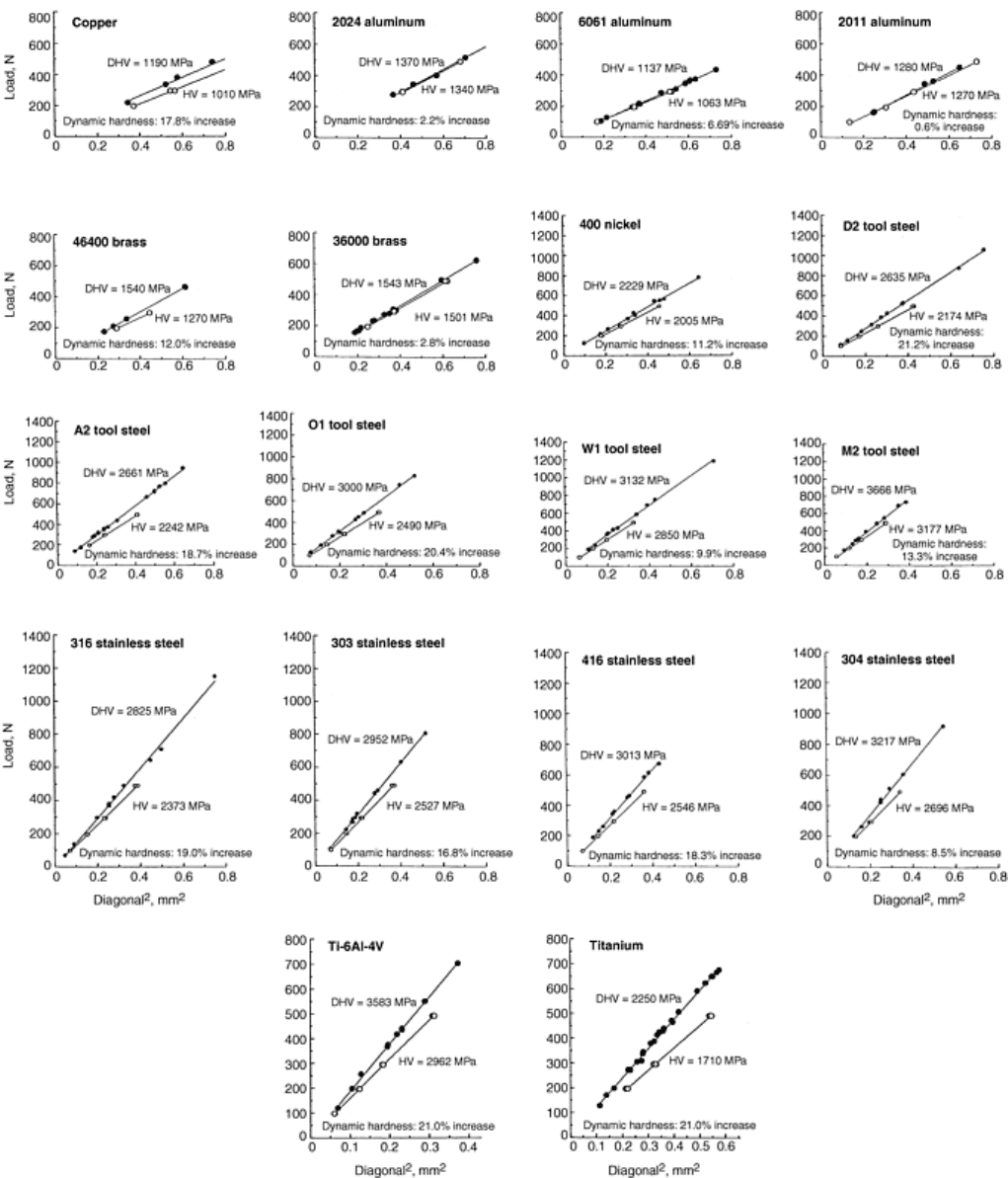
Fig. 5 Plots of load versus square of the mean indentation diagonal for selected metals and alloys
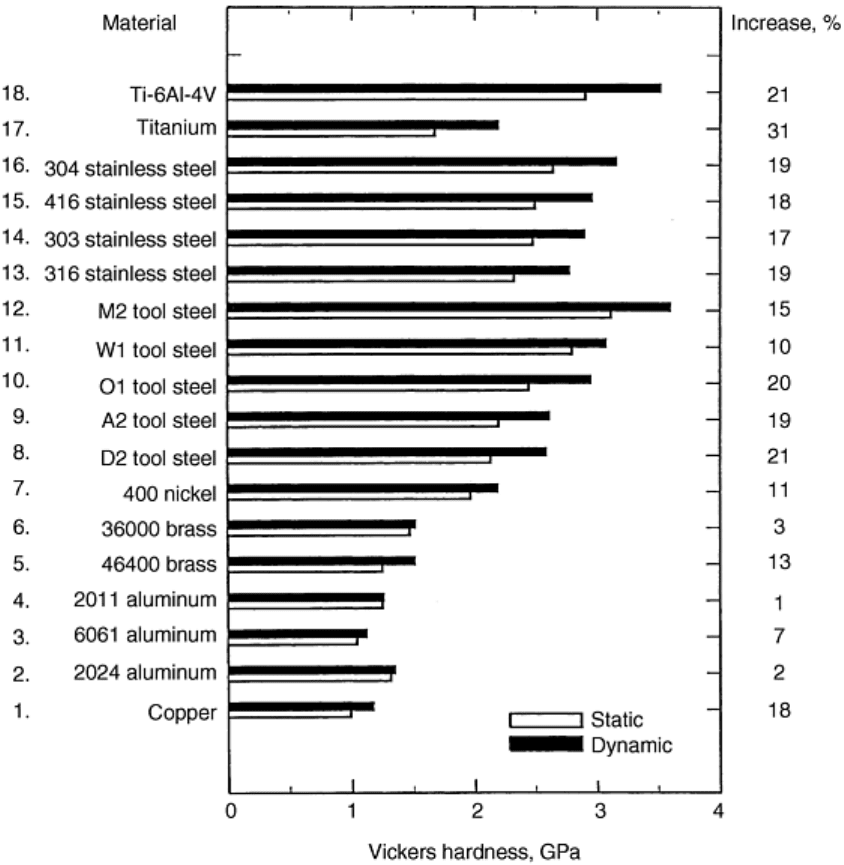
Fig. 6 Summary of static and dynamic Vickers hardness data for the metals and alloys included in Fig. 5.
The numbers on the right indicate the percentage increase in dynamic hardness over the static hardness.
Velocity of the Indenter and Deformation Strain Rate. The velocity of the indenter during the penetration is
calculated from the recorded strain (Fig. 4) from a gage (mounted on the cantilever beam) signal. The strain
signal is converted to the displacement at the free end of the cantilever beam using basic beam-theory
equations. The slope of this curve gives an estimate of the velocity of indenter during penetration. Note that the
profile of this curve is considerably different from the incident compression (C
impact
) pulse shown in Fig. 2(b),
but the duration of both curves is close to 100 μs. The plot indicates that the indenter penetrates with a higher
velocity close to 7.25 m/s during the early stages and then slows down to 1.5 m/s before unloading. The initial
high velocity is due to the low resistance encountered by the indenter sharp-tip as it penetrates the specimen.
With continued penetration, the area resisting the indenter increases due to the pyramidal shape of the indenter,
and the velocity decreases. It is cautioned here that the velocity of the indenter in the current method is
measured while the indenter is in contact with the specimen and should not be confused with the free velocity
of the indenter in air used in the rebound method.
Hardness has been related to yield stress of metallic materials through Tabor's relationship (H = 3 × Y), where
H is the indentation hardness and Y is the yield stress at 8% strain (Ref 1, 2). However, this equation has been
verified only for static indentations. To verify the current results on dynamic hardness and to establish the
validity of Tabor's relationship in the dynamic regime, it is necessary to estimate the strain rate of deformation
during the dynamic indentation process. However, in an indentation experiment, the accumulated plastic strain
varies considerably within the plastic zone. The residual strain is maximum in a region closer to the tip of the
indentation and decreases rapidly at distances farther away. The nonhomogeneity of plastic strain results in a

nonuniform strain rate within the plastic zone. Therefore, an average measure of strain rate will be defined from
global velocity measurements as follows:
(Eq 3)
Any measure of the size of indentation, such as the diagonal or the depth of indentation, could be used because
the order of strain rate does not vary significantly with either of the measurements. Based on the loading range
employed in this investigation, the size of the diagonal of the indentation was measured to be approximately 0.6
to 0.7 mm. The velocity of the indenter was chosen as the lesser of the two velocities (1.5 m/s) in Fig. 4. This is
because the deformation volume is greater during the later stages of the penetration process. Accordingly, the
average strain rate was determined to be around 2200/s. This value of strain rate is in reasonable agreement
with the dynamic spherical indentation experiments by Mok and Duffy (Ref 17), who used a split Hopkinson
pressure bar and determined the strain rate to be around 1500/s. Finite element simulations of the dynamic
indentation process also confirmed that a large portion of the plastic volume experiences a strain rate in the
range of 1000 to 2000/s (Ref 24).
Validation of Tabor's Relationship in Dynamic Indentation Experiments. To verify the validity of Tabor's
equation in the dynamic regime, uniaxial compressive stress-strain response was obtained at a quasi-static strain
rate of around 0.001/s and a dynamic strain rate of around 2000/s for all the materials. The quasi-static
experiments were performed on a servohydraulic machine, and the high-strain-rate experiments were performed
using a compression split Hopkinson pressure bar. Specimen sizes of 4 to 6 mm diameter and 8 to 12 mm
length were used in these experiments. The stress-strain curves at these two strain rates are given in Fig. 7 for
the same materials included in Fig. 5 and 6. For rate-sensitive materials, significant increase in yield strength
can be observed. From the given stress-strain curves, yield stress at 8% strain was obtained and plotted against
the corresponding hardness in Fig. 8. For static data, the regression line yields a slope of 3, thus validating the
Tabor relationship. Similar analysis of the dynamic data yields a slope slightly less than 3. This slight variation
may be expected because the strain rate in the indentation test determined according to Eq 3 is an average
measure. Moreover, the stress-strain data generated from the Hopkinson pressure bar experiment was not
exactly at one constant strain rate but varied between 1800 and 2200/s for different materials. Nevertheless, the
data validate the Tabor's relationship under dynamic conditions also (i.e., DHV=3Y
d
, where Y
d
is the yield stress
at 8% strain).
